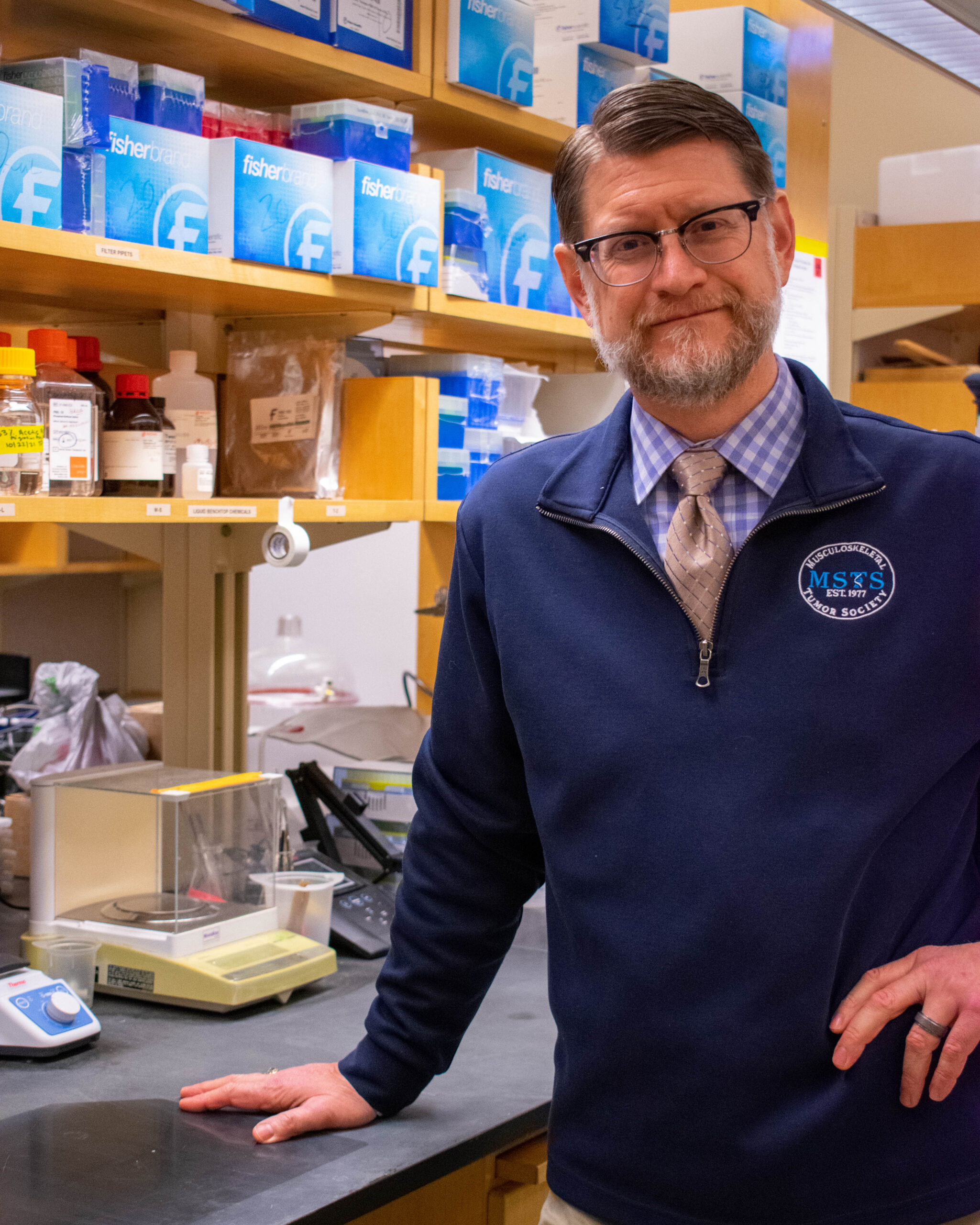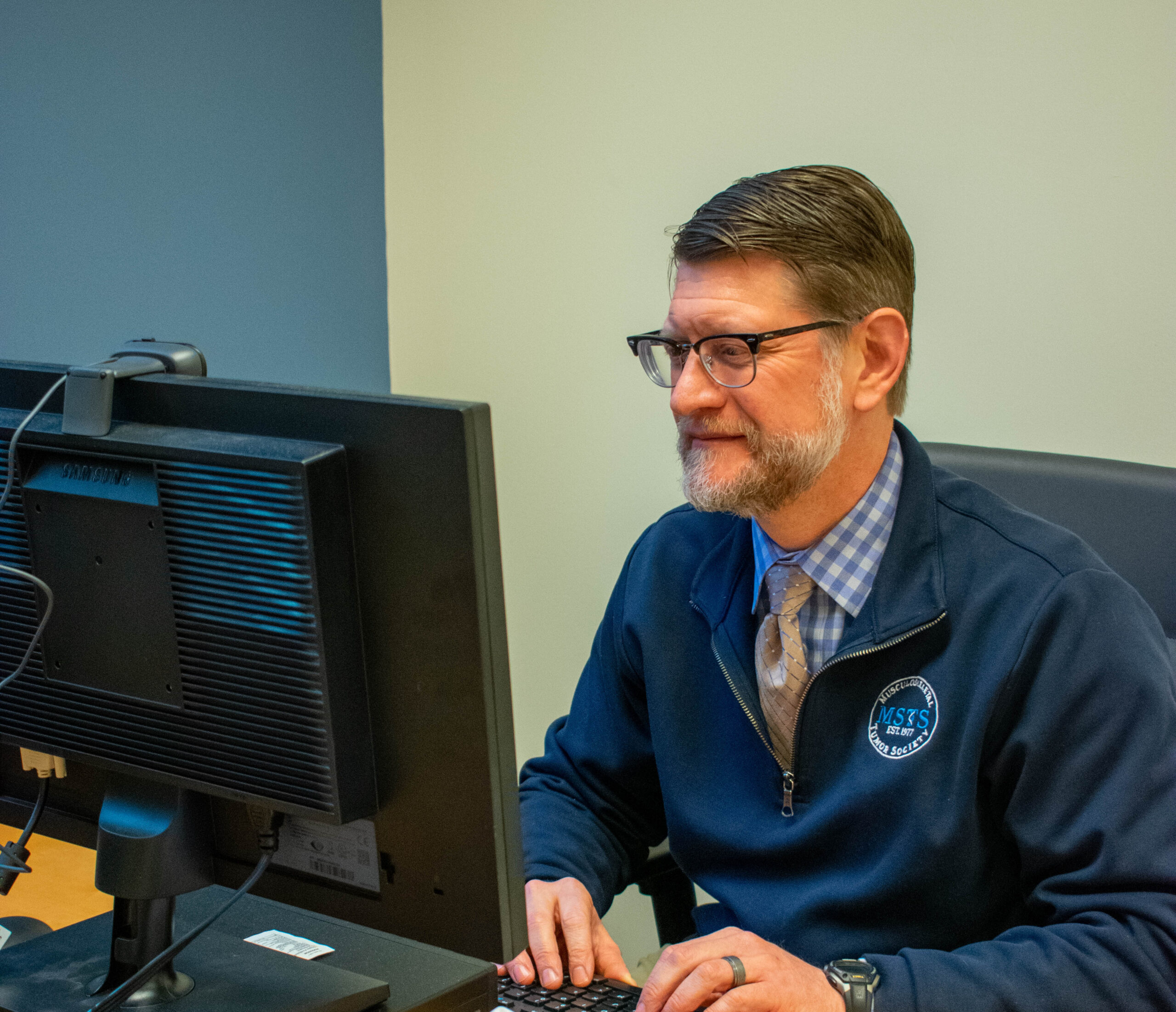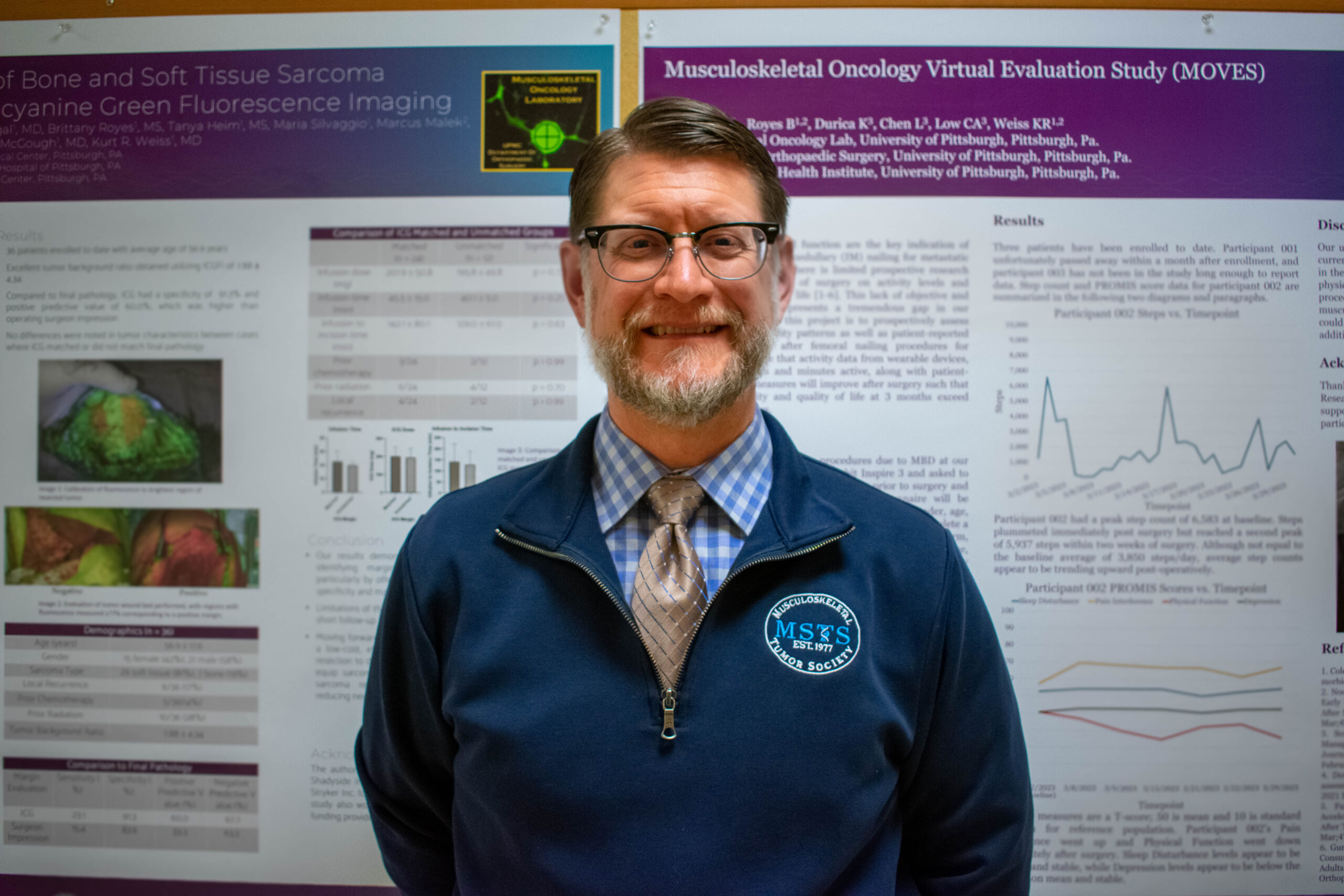Can you share a bit about your early life and what sparked your interest in research, medicine and orthopaedics/bioengineering?
I was born and raised in Pittsburgh’s North Hills, attending St. Teresa Elementary School and North Hills High School. I was diagnosed with osteosarcoma, a rare pediatric/adolescent/young adult bone cancer, at the age of 15. The cancer had already metastasized (spread) to my lungs at the time of diagnosis, giving me a very poor prognosis. The tumor in my right tibia was removed by the late Henry Mankin, MD. Despite surgery and chemotherapy, the cancer returned to my lungs. Not having any other good options, I participated in an experimental treatment, which was ultimately successful. Unfortunately, complications from the cancer in my leg resulted in amputation from above the knee. This difficult clinical course enabled me to observe first hand the medical and surgical challenges that can result from musculoskeletal cancer.
What were some pivotal moments or influences during your education that shaped your research interests?
My experience with the experimental chemotherapy demonstrated forcefully that cancer research saves lives. My first research experience was with Christopher Evans PhD, DSc in the Ferguson Lab during my undergraduate years at Notre Dame. I fell in love with research and worked with Dr. Evans, the first Henry Mankin Endowed Professor at the University of Pittsburgh, on the human gene therapy for rheumatoid arthritis. This was the first application of gene therapy in orthopaedic surgery in history. After my first year of medical school at Jefferson Medical College, I performed a summer research internship at MD Anderson Cancer Center in Houston, Texas. Here I worked in the Lab of Eugenie Kleinerman MD, who had developed the osteosarcoma treatment that had saved my life.
This marked my first experience with pediatric bone sarcoma research. Between the second and third years of medical school, I performed a one-year research fellowship with the Howard Hughes Medical Institute/National Institutes of Health Research Scholars Program. This year was spent in the Pediatric Oncology Branch of the National Cancer Institute in the Lab of Lee Helman MD. I performed research on osteosarcoma and Ewing sarcoma metastases. I then started the orthopaedic surgery residency here at Pitt and spent my Lab year with Johnny Huard PhD, the second Henry Mankin Professor. During this year I performed original osteosarcoma research that formed the basis of research we are still performing in the Musculoskeletal Oncology Laboratory to this day.

What were your initial career goals when you started your journey in research, and how have they evolved over time?
My initial goal upon returning to Pitt as an attending surgeon scientist was straight forward: to build a translational sarcoma research program at the University of Pittsburgh. This sounds simple but it has taken over a decade of development to help build a program that is robust, sustainable, and thriving. For example, we began the Musculoskeletal Oncology Tumor Registry and Tissue Bank (MOTOR) in 2012 with absolutely zero experience in the banking of clinical samples. After many failures, we adopted protocols that have enabled us to build a tumor bank with over 12,000 clinical samples, making this one of the largest sarcoma tissue repositories in North America.
Are there specific achievements or milestones you aspire to reach in your career?
One day I hope to earn the Henry Mankin Endowed Chair. Dr. Mankin was my surgeon and inspired me to become a musculoskeletal oncologist and a surgeon scientist. Besides being my doctor and a founder of the Musculoskeletal Tumor Society (MSTS), Dr. Mankin was the greatest orthopaedic surgeon scientist of his generation. Nothing would give me greater pride than to carry his legacy forward.
Could you provide an overview of your current role at the BMRC and responsibilities in your research position?
My present role in the BMRC is that I am an Associate Professor and Advisory Dean in the School of Medicine. I serve as the Vice Chair of Translational Research for the Department of Orthopaedic Surgery. I am our senior translational surgeon scientist and a founding member of the Pittsburgh Cure Sarcoma (PCS) patient advocacy group and the Pittsburgh Sarcoma Research Collaborative (PSaRC). I direct the Musculoskeletal Oncology Lab along with Ines Lohse PhD, who is a Research Assistant Professor in our Department.

What projects are you currently working on, and what excites you most about them?
Our projects focus on understanding metastatic potential in sarcomas. That is, what attributes and processes enable sarcomas to spread from the primary location to the lungs? We attack this problem from every angle: the sarcoma cells themselves, the tumor microenvironment, immunology, and cell signaling. We want to be the world’s experts in sarcoma metastatic biology, and eradicate metastatic disease as a source of mortality for patients of all ages with sarcoma.
Our Lab Co-Director Dr. Lohse brings with her unique and powerful experience with drug sensitivity testing (DST) in sarcomas. Not all cancer responds similarly to the same treatments. DST screening enables us to select the best treatment for an individual patient and is a beautiful example of personalized medicine. It is particularly important for patients with advanced disease.
Research can be demanding. How do you maintain a balance between your professional and personal life?
This is challenging. My professional life consists of my roles as a surgeon, scientist, administrator, and advisory Dean. Similarly, the roles in my personal life include spouse, father, sibling, and son. It is indeed difficult to balance all of these important roles and I continue to try to do my best at all of them.
Are there skills or qualities you believe are essential for success in the field of research?
There is no small role for luck in research. For certain, it is a long road full of many setbacks. Therefore, a scientist must be resilient and committed. As Einstein said, success is the ability to go from failure to failure without losing one’s enthusiasm. If Einstein, as brilliant as he was, suffered setbacks, we must also be prepared to overcome many obstacles.
Are there any recent developments or breakthroughs in your field that particularly fascinate you?
The ability to evaluate the genetic information of a single cell in relationship with other cells in its vicinity is extraordinary. This single cell sequencing and spatial transcriptomic technology enables us to understand the interactions between a cancer cell and the tumor microenvironment as we never have before.
Pictures are data. No area of medicine uses imaging (X-rays, CT scans, MRI scans) to the extent that orthopaedic surgeons do every day. The use of Artificial Intelligence (AI) to help us use these images as data points that enable us to better understand orthopaedic pathology and the impacts of our interventions is unprecedented.

Are there specific areas within your field that you are particularly interested in exploring further in the coming years?
We have begun field-leading clinical studies to explore the use of indocyanine green (ICG) fluorescence imaging in sarcoma surgery. We are also at the forefront of using biometric data and patient-reported outcomes measures to understand the experiences of patients who undergo surgery for metastatic cancer. Both of these clinical studies could have enormous impacts on the field of musculoskeletal oncology.


